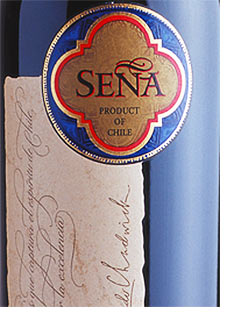Seña, Clos Apalta, A
 lmaviva
lmaviva

It's not just Chile that links all these three wines, or that they are their country's triumvirate of top labels. In Bordeaux, La Place is the very traditional distribution network that moves wine from chateaux to negociants. It's the sort of thing you might expect to fade into obsolescence in the modern era, but quite the contrary; more and more New World and Super Tuscan wines pass through La Place these days, including these Chilean superstars. I had the pleasure of tasting all three yesterday. Sena was the most intense, Almaviva the most vibrant and Clos Apalta, with the sneaky benefit of an extra year of age, the most textured and flavoursome now. /NT
2017 Seña
They explained how the 2017 Seña was produced with 'grapes that were handpicked in the morning and transported to the winery in 12-kilogram boxes for a careful inspection on a double sorting table.' …This has less aromatic exuberance and is a more serious vintage with good concentration and weight, not as aerial as the 2016…. This is more powerful, structured and concentrated, like a drier version of the 2015, with some grainy tannins, more acidity, more austerity and less primary fruit. The tannins have some grip (the earlier harvest perhaps?) and might need a little bit of time in bottle, and the wine seems to have what it takes to develop nicely in bottle… Just for the record, the varietal breakdown is 52% Cabernet Sauvignon, 15% Malbec, 15% Carmenère, 10% Cabernet Franc and 8% Petit Verdot, reflecting a good year for Carmenère and Cabernet Franc. 96+ points, Luis Gutierrez, robertparker.com, Aug 2019
2017 Almaviva
2017 was an unusual year, warm and extremely dry, and the harvest and the whole cycle was two to three weeks earlier than normal. That is the context for the 2017 Almaviva, whose vines saw extremely low yields and produced concentrated juice. The bottled blend is 65% Cabernet Sauvignon, 23% Carmenère, 5% Cabernet Franc, 5% Petit Verdot and 2% Merlot.... It's a riper, rounder and softer vintage, with moderate acidity and a tender mouthfeel, really marked by very high temperatures all year round. They used a little more Petit Verdot in the blend, but there is no overripeness. The wine shows some herbal aromas (I really notice the touch of the Carmenere this year). They harvested extremely early (three weeks earlier than normal!) and were able to keep the tension in the wine, and it has a polished mouthfeel and very round tannins. It's a nicely crafted red blend, and they were able to overcome the difficulties of the year; I see the style of something between 2016 and 2015, quite compact. It might require some more bottle age to open up, and it should develop nicely in bottle. 94+ points, Luis Gutierrez, robertparker.com, Aug 2019
2016 Clos Apalta
The 2016 Clos Apalta is a blend of 64% Carménère (higher than in 2015), 19% Cabernet Sauvignon and 17% Merlot... I've seen a great improvement in Carménère in Chile in the last few years, perhaps since they stopped wanting to grow it everywhere and focused on the places where it grows well, like the Apalta region. They have also learned to tame the green aromas and fierce tannins and alcohol and to produce much more harmonious reds, like this aromatic example that reveals spice, tobacco leaves, red fruit and floral notes without noticeable alcohol or excess ripeness. The oak is surprisingly well integrated for such a young wine, and there is harmony, concentration and balance to make it age in bottle for a long time. The palate is full-bodied, and the tannins are fine-grained and in balance with the rest of the components, coming through as a compact and powerful yet elegant red. This has to be one of the finest Clos Apaltas of all time. 96 points, Luis Gutierrez, robertparker.com, Aug 2019
Offered subject to availbility; for shipment Spring 2020
| Vintage | Description | Cs Sz | Bt Sz | Cs | Bts | ||
|---|---|---|---|---|---|---|---|
| 2017 | Almaviva (Puente Alto) | 6x | 75cl | 0 | 0 | Buy | |
| 2016 | Casa Lapostolle Clos Apalta | 6x | 75cl | 0 | 0 | Buy | |
| 2017 | Sena (Aconcagua Valley) | 6x | 75cl | 0 | 0 | Buy |